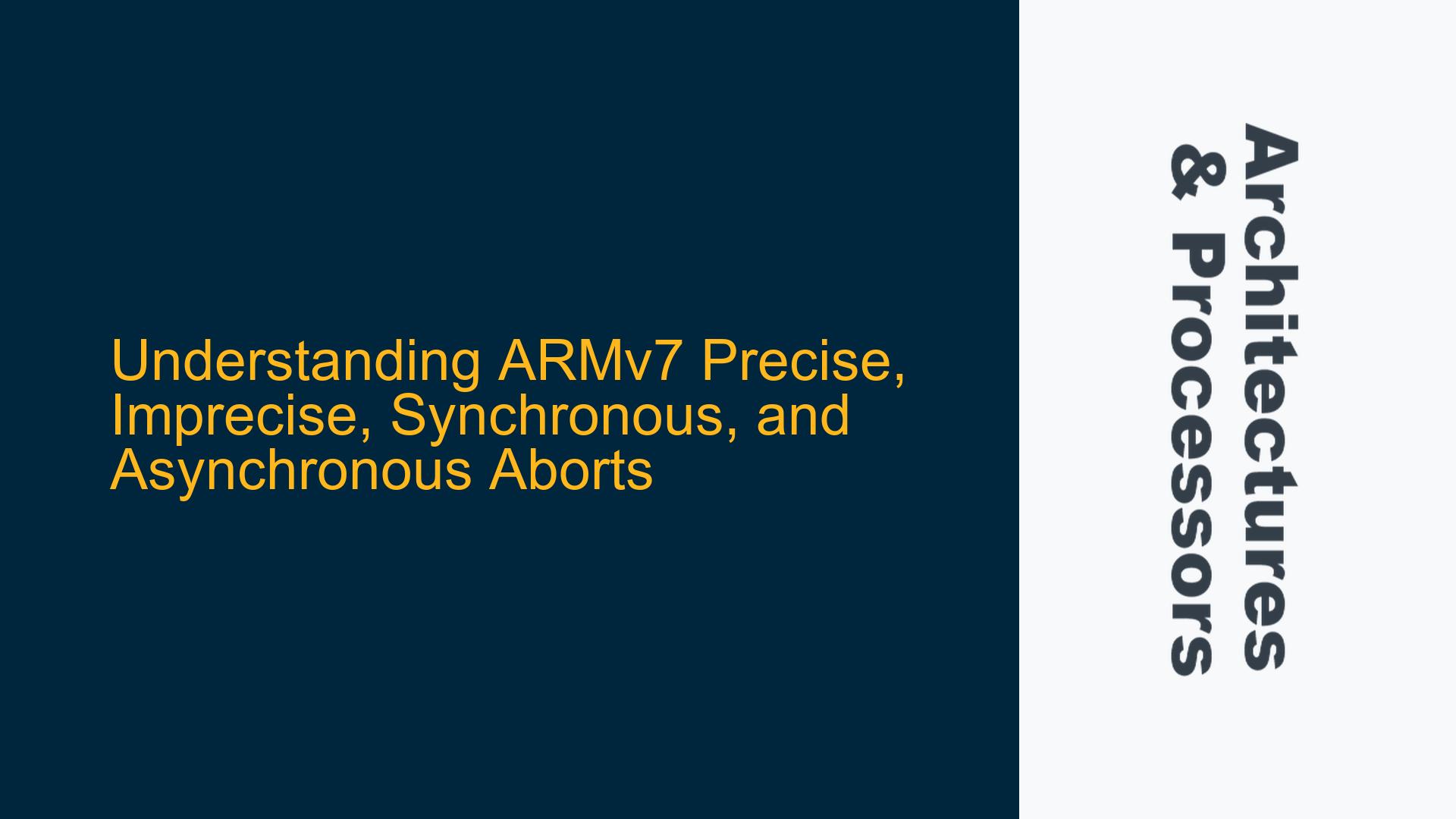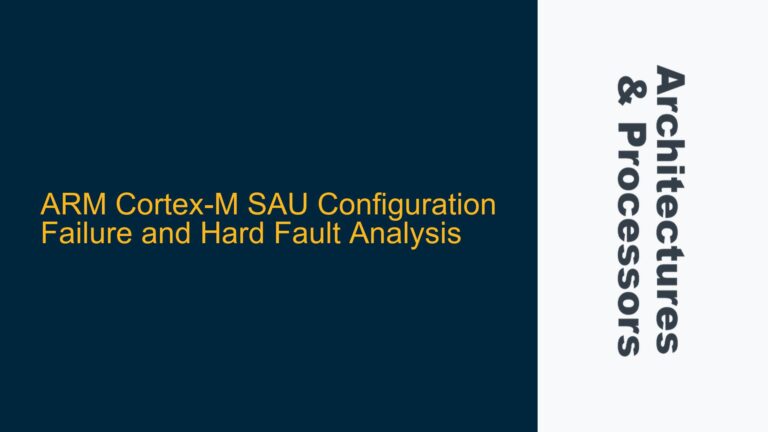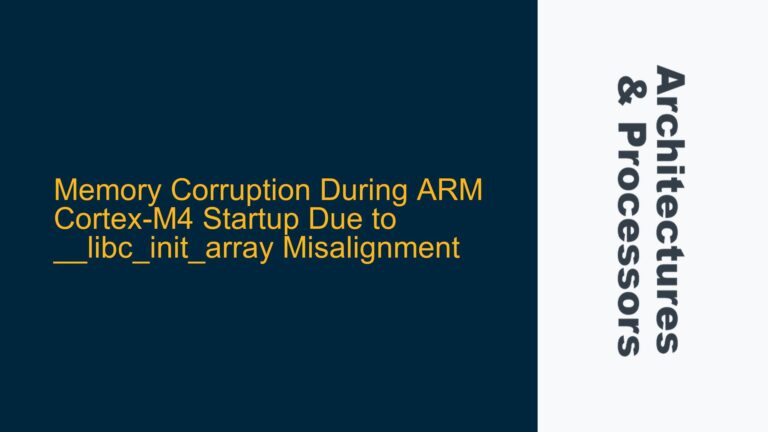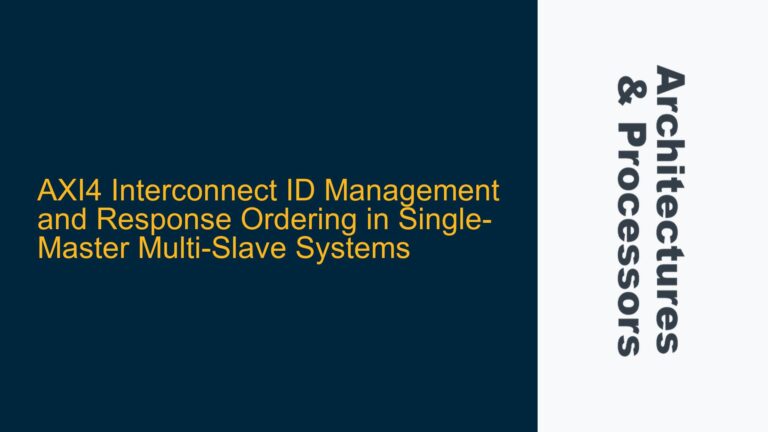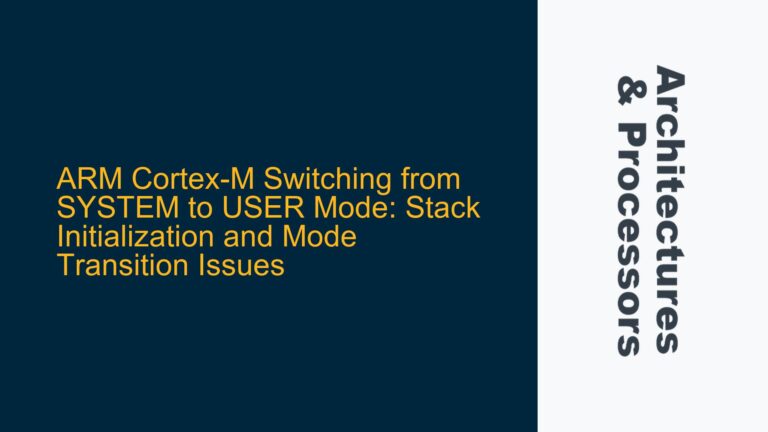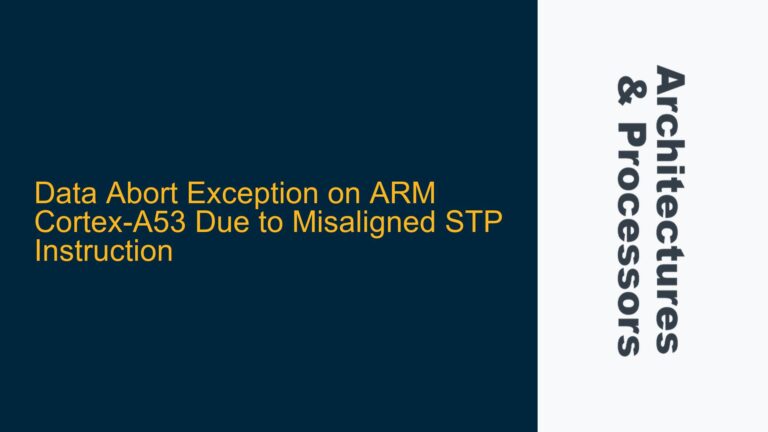ARMv7 Abort Types: Definitions and Key Differences
In ARMv7 architecture, aborts are critical exceptions that occur when the processor encounters an issue during instruction execution or memory access. These aborts are categorized based on their timing and precision, leading to terms such as precise, imprecise, synchronous, and asynchronous aborts. Understanding these categories is essential for debugging and optimizing ARM-based systems.
A precise abort is an exception where the processor can precisely identify the instruction that caused the abort. This means the program counter (PC) at the time of the abort points directly to the offending instruction. Precise aborts are typically caused by issues such as invalid memory accesses, alignment faults, or permission violations. The processor halts execution at the exact point of the fault, allowing developers to diagnose and resolve the issue efficiently.
An imprecise abort, on the other hand, occurs when the processor cannot definitively identify the instruction that caused the fault. This often happens due to the pipeline nature of modern processors, where multiple instructions are in various stages of execution simultaneously. For example, a memory access fault might not be detected until several instructions after the actual faulting instruction. Imprecise aborts are more challenging to debug because the program counter does not point to the exact instruction that caused the issue.
A synchronous abort is an exception that occurs as a direct result of executing a specific instruction. The abort is "synchronized" with the instruction stream, meaning the faulting instruction can be identified. Synchronous aborts are typically precise because the processor can correlate the abort with the exact instruction being executed.
An asynchronous abort is not directly tied to the instruction stream. Instead, it is caused by external events, such as interrupts or system-level errors, that occur independently of the currently executing instructions. Asynchronous aborts can be either precise or imprecise, depending on whether the processor can identify the source of the fault.
The confusion in the discussion arises from the overlap between these terms. For instance, a precise abort can be either synchronous or asynchronous, depending on the cause. Similarly, an imprecise abort is inherently asynchronous because it cannot be tied to a specific instruction. To clarify, let’s break down the relationships:
- Precise Synchronous Abort: The abort is caused by a specific instruction, and the processor can identify the exact faulting instruction. Example: A data abort due to an invalid memory address.
- Precise Asynchronous Abort: The abort is caused by an external event, but the processor can still identify the exact point of interruption. Example: An interrupt that halts execution at a precise instruction boundary.
- Imprecise Asynchronous Abort: The abort is caused by an external event, and the processor cannot identify the exact faulting instruction. Example: A memory system error that manifests several instructions after the actual fault.
Understanding these distinctions is crucial for diagnosing and handling exceptions in ARMv7 systems. Misinterpreting the type of abort can lead to incorrect debugging assumptions and ineffective solutions.
Causes of Precise, Imprecise, Synchronous, and Asynchronous Aborts
The causes of aborts in ARMv7 architecture are diverse and depend on the specific type of abort. Below, we explore the common causes for each category.
Causes of Precise Aborts
Precise aborts are typically caused by issues that the processor can detect and attribute to a specific instruction. Common causes include:
- Invalid Memory Access: Attempting to access a memory location that is not mapped or protected. For example, dereferencing a null pointer or accessing an unmapped peripheral register.
- Alignment Faults: Accessing memory with an unaligned address. ARMv7 requires certain data types to be aligned to specific boundaries (e.g., 4-byte alignment for 32-bit words).
- Permission Violations: Attempting to access memory with insufficient privileges. For example, a user-mode application trying to access a kernel-mode memory region.
- Undefined Instructions: Executing an instruction that the processor does not recognize or support.
Causes of Imprecise Aborts
Imprecise aborts are often caused by issues that are not immediately detectable at the instruction level. Common causes include:
- Memory System Errors: Faults in the memory subsystem, such as ECC (Error-Correcting Code) errors or bus faults, that are detected after the faulting instruction has passed through the pipeline.
- Write Buffer Issues: Delayed write operations that fail after the original instruction has completed. For example, a write to a peripheral register that fails due to a bus error.
- Pipeline Effects: The inherent nature of pipelined execution, where multiple instructions are in flight, can delay the detection of faults.
Causes of Synchronous Aborts
Synchronous aborts are directly tied to the instruction stream and are typically caused by:
- Data Aborts: Occur when a load or store instruction accesses an invalid memory location.
- Prefetch Aborts: Occur when the processor attempts to fetch an instruction from an invalid memory location.
- Undefined Instructions: Executing an instruction that is not supported by the processor.
Causes of Asynchronous Aborts
Asynchronous aborts are caused by external events and include:
- Interrupts: External signals that interrupt the normal flow of execution. These can be precise if the processor halts at an instruction boundary or imprecise if the interrupt is serviced mid-instruction.
- System Errors: Faults in the system infrastructure, such as power failures or clock glitches, that are not tied to specific instructions.
- Debug Events: Debugger interventions that halt execution asynchronously.
Understanding these causes is essential for diagnosing and resolving aborts in ARMv7 systems. Each type of abort requires a different approach to debugging and handling.
Diagnosing and Resolving ARMv7 Aborts: Best Practices and Solutions
Diagnosing and resolving aborts in ARMv7 systems requires a systematic approach that considers the type of abort, its cause, and the specific context in which it occurs. Below, we outline best practices and solutions for handling precise, imprecise, synchronous, and asynchronous aborts.
Diagnosing Precise Aborts
Precise aborts are relatively straightforward to diagnose because the processor provides detailed information about the faulting instruction. Follow these steps:
- Examine the Fault Status Register (FSR): The FSR contains information about the cause of the abort, such as the type of fault (e.g., permission violation, alignment fault) and the memory domain involved.
- Check the Fault Address Register (FAR): The FAR contains the memory address that caused the abort. Use this information to identify the faulty memory access.
- Analyze the Program Counter (PC): The PC points to the exact instruction that caused the abort. Disassemble the code at this address to understand the context of the fault.
- Review Memory Maps and Permissions: Ensure that the memory region being accessed is mapped and has the correct permissions for the current execution mode (e.g., user vs. kernel mode).
Diagnosing Imprecise Aborts
Imprecise aborts are more challenging to diagnose because the processor cannot identify the exact faulting instruction. Follow these steps:
- Enable Debugging Features: Use hardware debugging tools, such as JTAG or ETM (Embedded Trace Macrocell), to trace the instruction stream and identify potential fault sources.
- Check System Logs: Review system logs for memory subsystem errors, bus faults, or other anomalies that might indicate the cause of the abort.
- Isolate the Fault: Use techniques such as binary search or fault injection to narrow down the source of the fault.
- Review Pipeline Behavior: Understand the pipeline architecture of the processor and how it might delay the detection of faults.
Handling Synchronous Aborts
Synchronous aborts are typically handled by the operating system or runtime environment. Follow these steps:
- Implement Exception Handlers: Write exception handlers for data aborts, prefetch aborts, and undefined instructions. These handlers should log the fault details and attempt to recover if possible.
- Validate Memory Accesses: Use techniques such as bounds checking and null pointer detection to prevent invalid memory accesses.
- Enforce Alignment Requirements: Ensure that all memory accesses comply with the alignment requirements of the processor.
Handling Asynchronous Aborts
Asynchronous aborts require a different approach because they are not tied to specific instructions. Follow these steps:
- Implement Interrupt Service Routines (ISRs): Write ISRs to handle external interrupts and system errors. These routines should log the event and attempt to recover if possible.
- Use Watchdog Timers: Implement watchdog timers to detect and recover from system hangs or crashes caused by asynchronous aborts.
- Monitor System Health: Use hardware monitoring tools to detect anomalies such as voltage drops, temperature spikes, or clock glitches that might cause asynchronous aborts.
General Best Practices
- Enable Debugging Features: Use hardware and software debugging tools to trace and diagnose aborts.
- Implement Robust Error Handling: Write exception handlers and ISRs that log fault details and attempt recovery.
- Validate Inputs and Memory Accesses: Use techniques such as bounds checking and null pointer detection to prevent faults.
- Understand Processor Architecture: Familiarize yourself with the pipeline, memory system, and exception handling mechanisms of the processor.
By following these best practices, developers can effectively diagnose and resolve aborts in ARMv7 systems, ensuring reliable and efficient operation.
